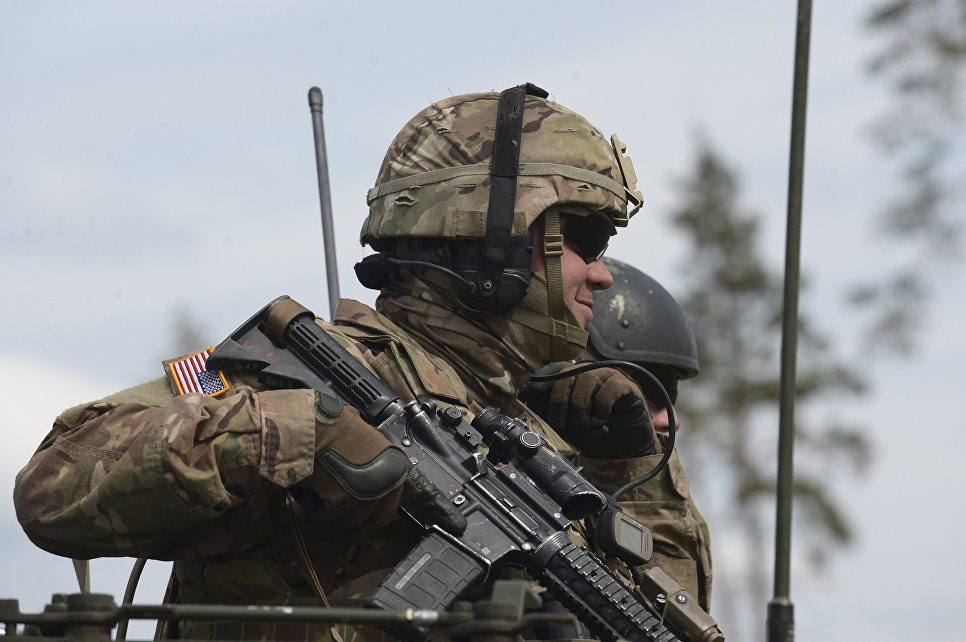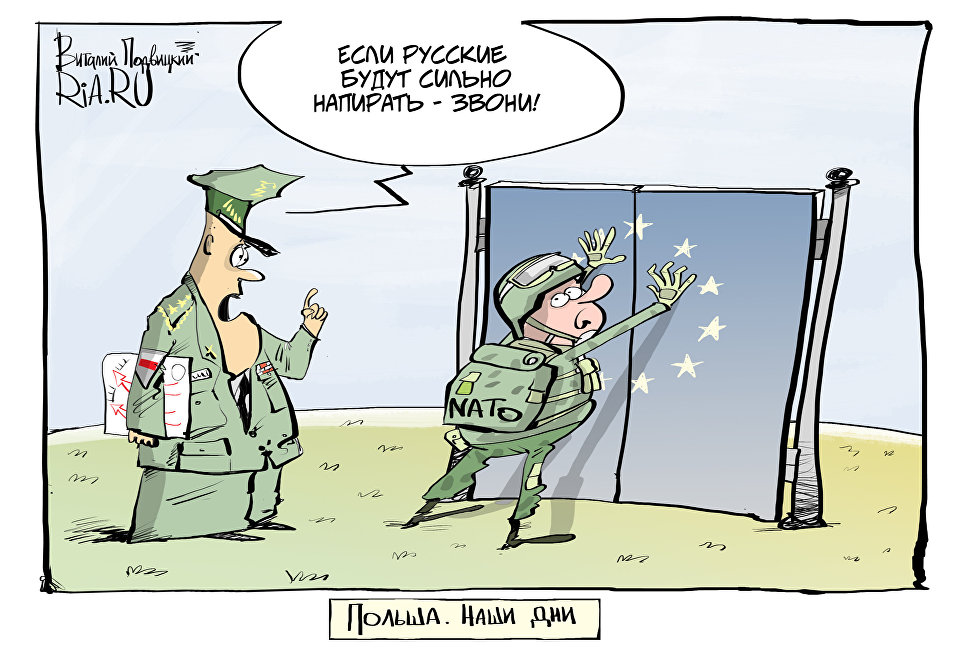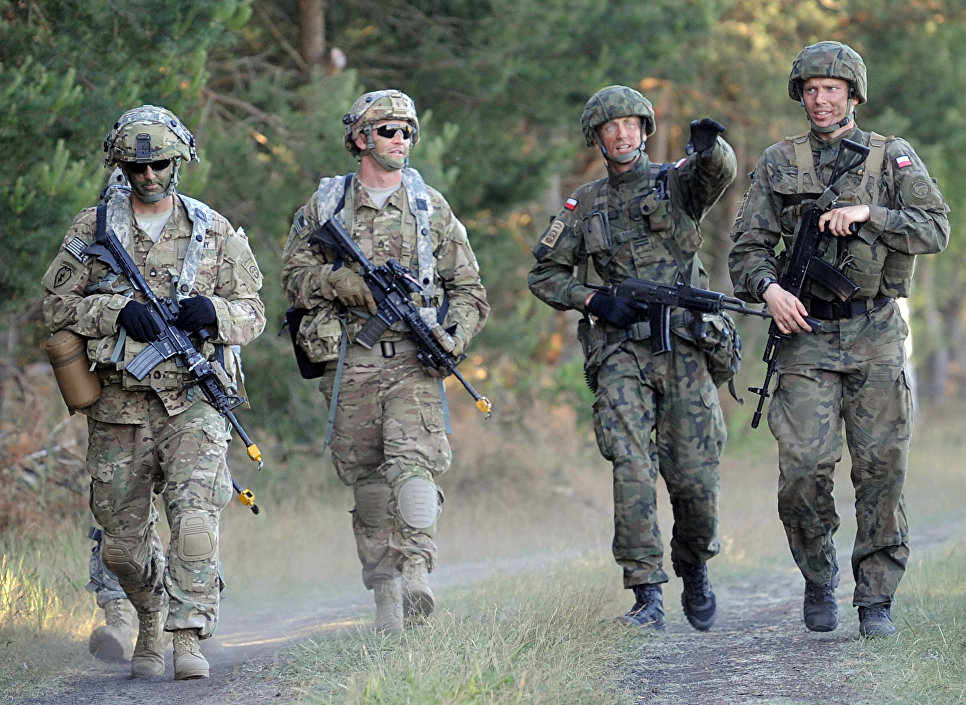This is a speed translation of an analytical article by Rostislav Ishchenko from the 7th of July 2016, published at his channel on Kont.
The NATO summit will begin in Warsaw on Friday. For two days (8 and 9 July), senior officials and generals will discuss a lot of technical and political issues. We are, however, interested in only one item on the agenda of the event. In Poland, the Alliance is going to once again discuss relief measures to the “Russian threat”.
As is the custom in the recent years, the “threat” is felt particularly acutely by the Balts and Poles, who demand the deployment on their territories of additional contingents of Western European and American allies.
Washington and London pretend to be impressed by the fears of the limitrophes, and agitate for meeting requests for strengthening NATO forces on the Russian border. We are talking about dislocation of four battalions.
In terms of the real military strengthening of the block’s abilities on the north-western borders of Russia, this gain is negligible. The American military analysts argue that even a dislocation in the region of four additional full brigades will not allow NATO to hold out much longer in the case of a real military conflict.
In fact, we are only talking about whether it will take the Russian troops one or two weeks to reach the Oder line. Or more precisely, how many US troops will need to be hastily evacuated from Poland and the Baltic states, if suddenly something goes wrong and, contrary to common sense, a military conflict in this area happens.

A US soldier during the 2016 Saber Strike exercises in Estonia.
Protection Poles and the Baltic states as a diversionary tactics
So, the United States believes that the Russian group on the Baltic borders now has absolute superiority, which it is impossible to stop by unfolding of either four or sixteen battalions. At the same time, as a result of NATO’s war hysteria of NATO, Russia decided to deploy in the western direction three new high-grade divisions, and another army corps in Kaliningrad.
One must say that Moscow has the potential to deploy new divisions faster than NATO would be able to collect and deliver their battalions to the area of the limitrophe’s. That is, theoretically, by provoking a military confrontation, the US and NATO impair their strategic position in the region.

Poland today: “If the Russians start pushing too hard, call us.”
A question: Why do they scare Moscow with “paper tigers”, if they know that as a result they will be worse off?
And, yes, they know it. Not least because Washington, which was initially swearing to deliver all four of the desired battalions by themselves, insisted on the separation of the burden in half – two battalions from the US and two from Western European allies. The Germans and the French (and who else would allocate the battalions, if not them) are not enthusiastic. And quite a lot of time will pass between the principal decision and the actual appearance of the troops.
Not only in Moscow, but also in European capitals they are well aware that in case of war, a battalion or two would not make a difference. European politicians, though sometimes pretending to be naive, are well aware that millions of Germans and French, who would be happily trying on helmets and flak jackets and rushing off to the eastern front to protect “European values” in the face of Latvians and Poles, is the story of fantasy. And yet the US successfully force through the NATO program of “protection” of small but very proud Eastern European allies, who regularly pull the tiger’s whiskers, feeling drunken from their own boldness.

Joint parachuting of American, British and Polish troops during Anakonda-2016 on Polish territory.
The answer to the question – why is it necessary – could be obtained based on the area of concentration of the main Russian group. Except for the Kaliningrad exclave, which is under threat simply by virtue of its isolation, more than half of the newly formed units are concentrated in the south-west of Russia, near the Ukrainian border, on which Kiev has already thrown some tantrums.
On the eve of the NATO summit, a confirmation that Moscow considers the south-western direction as the most explosive is, was given in a statement of the Minister of Foreign Affairs of Russia, Sergey Lavrov.
He warned our western friends and partners that, according to the available information, in the near future Kiev can organise a large-scale provocation that could lead to the resumption of full-scale hostilities in the area of the civil conflict in the Donbass.
Who needs new territories
Let us put two and two together, and add to this the undisguised (for the past two and a half years) desire of the USA to tie the hands of Russia by drawing it into a full-scale conflict in Ukraine. Let us not forget that it was the Balts and the Poles, who repeatedly promised to provide military support to Kiev in case of a “Russian aggression”.

Polish soldiers during international exercises Rapid Trident-2016 in Lvov region, Ukraine.
Recall also that a number of border states – the Eastern European members of NATO – are having problems with the Ukrainian territories inhabited by their respective minorities and formerly being part of the these countries. In addition to traditional Poland, Hungary and Romania, even the Bulgarian government has expressed concerns about the protection of the rights of compatriots and supported the idea of creation in Ukraine of a Bulgarian autonomy.
What do we get? The high risk of a sharp intensification of the Ukrainian conflict together with its simultaneous internationalization, with the participation of the Eastern European members of NATO. Of these, it is Poland and the Baltic States (exactly the countries that were promised the new battalions) are the most militantly set.
And now let us turn to history. In 1939, the courage of Warsaw, which rejected all German demands and literally longing for war, was backed by the British and French guarantees. Polish army was numerically comparable with the German. They did not yet know in Poland about the real overwhelming technical superiority of the Reich, and the absolute intellectual superiority of its general staff.
The military leaders of the country believed that they would be easily able to hold out for a few weeks or even a couple of months. Then the French would start an offensive: French army at the time was considered to be strongest in the world (wrongly, but no one knew about it), and with them would come the British. And after that the Poles were going to share the spoils of war, and to acquire new territories. By the way, the very same East Prussia, a third of which now comprises the Kaliningrad region.
Is a blockade of the Kaliningrad region possible
In general, to encourage Eastern European cannon fodder for the war, it was necessary to create an illusion of security and proximity to an easy victory.
In the first half of the twentieth century, this illusion was provided by the Anglo-French guarantee. Now simple NATO guarantees are not enough. Even limitrophe’s became smarter and doubt that Americans (and Europeans) will risk of full-scale war with a nuclear power because of the ambitions of Riga and Warsaw. Now contingents of US and Western Europe in their respective territories should become such a guarantee.
Limitrophes believe that in the event of hostilities, these forces will inevitably fall under attack. That is, in actuality the bigger partners would enter a war automatically – through the fact of death of their soldiers.
And the passage of the internal procedures, required for each individual NATO country would become involved in the conflict as part of the block, would be fast tracked in the event of an attack by the “insidious Russia” on the “peaceful American soldiers”.
This, in turn, means that the limitrophes, who had already long since gone over the brink in their Russophobia, will now completely lose their head from courageousness.
Very simple. In the event of a start of full-scale hostilities in Ukraine, it won’t be a problem to once again accuse Russia of aggression. And then, in accordance to giving assistance to the “young democracy” they would not even need to cross the border. It is sufficient to organize a blockade of the Kaliningrad region.
Not only a blockade is a hostile act, which is equated by the international law with military aggression. Moscow will in any case have to break through it. The region, Navy and the Army can not exist without communications with Big Land. And they can fully try to sink the ships and shoot down planes, which try to break the blockade, all the while crying that it was Russia attacking.

Soldiers of the Polish and American armies during the Anakonda-2016 exercises on the territory of Poland.
And then the limitrophes (just like the Poles in 1939) believe that in the face of the inevitable (in their opinion) American intervention, Russia would retreat.
By moving the Baltic pawn in the form of the four battalions (half of which is not theirs), the US is trying to solve a problem that they still didn’t man resolved – creating an outbreak of the Russian-European military confrontation. While they themselves are going to remain outside the conflict.
Firstly, no one knows when more battalions will arrive. Secondly, it is a lot easier to promptly evacuate a couple of battalions, than it was for the British to evacuate nearly 340 thousand of their own, French and Belgian soldiers from Dunkirk in 1940.
So that the risk of conflict comes not from the battalions incapable of anything, but from the minds of inadequate politicians that learn nothing from history.
